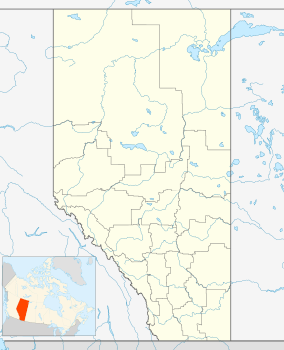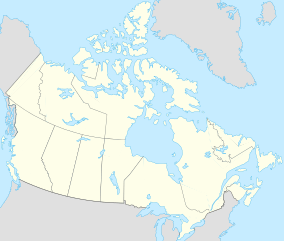Waterton Biosphere Reserve facts for kids
Quick facts for kids Waterton Biosphere Reserve |
|
|---|---|

Upper Blakiston Falls
|
|
| Location | Southwestern Alberta, Canada |
| Area | 66,761 hectares (257.77 sq mi) |
| Established | 1979 |
| Governing body | Waterton Lakes National Park, Waterton Biosphere Association. |
The Waterton Biosphere Reserve is a special natural area in Alberta, Canada. It was created in 1979 by UNESCO as part of its 'Man and the Biosphere' program. This reserve includes Waterton Lakes National Park and stretches from the Rocky Mountains to the Great Plains.
To the south, it connects with the Glacier Biosphere Reserve and National Park in Montana, USA. The reserve is managed by Waterton Lakes National Park and the Waterton Biosphere Association.
Contents
Amazing Nature in Waterton
The Waterton Biosphere Reserve is a place where many different types of environments meet. Because of the big changes in elevation, from high mountains to flat prairies, it has a huge variety of plants and animals.
Different Habitats
This reserve is home to many different natural areas, including:
- Prairie grasslands
- Aspen grove forests
- Subalpine forests
- Alpine tundra and high meadows
- Cliffs and lakes
- Freshwater wetlands
Even areas that have been used by people, like heavily grazed lands, are part of this rich mix.
Plants of the Reserve
The reserve boasts a wide range of plant life. In the prairie grasslands, you can find grasses like Danthonia species and prairie Junegrass. Aspen grove forests feature quaking aspen (Populus tremuloides).
Higher up, in the subalpine forests, you'll see trees like Douglas fir (Pseudotsuga menziesii), lodgepole pine (Pinus contorta), and limber pine (P. flexilis). Above the tree line, in the arctic-alpine areas, plants like Dryas octopetala thrive.
People and the Reserve
The Waterton Biosphere Reserve is not just for nature; people live and work there too.
Local Communities
In 1996, about 279 people lived in Waterton year-round. During the busy summer, the population grew to about 2,250 people. Most of the money earned in the area comes from tourism, especially in the 'buffer zone' of the reserve.
Farming, especially raising livestock, is also important. This happens mainly in the 'transition zone' and within the Blood Indian Reserve.
Learning and Community
The Waterton Biosphere Reserve helps organize events for the community. They hold public talks and forums about topics that local people care about. They also arrange fun outings and educational trips for students. This helps everyone learn more about the amazing environment around them.
How Big is Waterton?
The Waterton Biosphere Reserve covers a large area of land.
- The total size of the reserve is about 66,761 hectares (or 258 square miles).
- The 'core area', which is the most protected part, is 46,285 hectares (179 square miles).
- Around the core are 'buffer zones' covering 6,312 hectares (24 square miles).
- The 'transition areas', where people live and work, cover 14,164 hectares (55 square miles).



